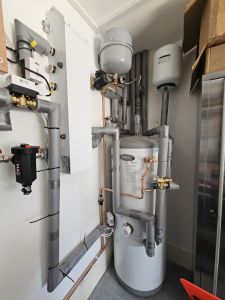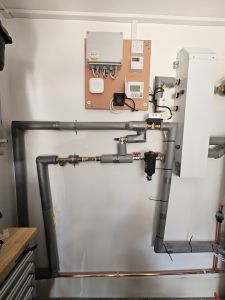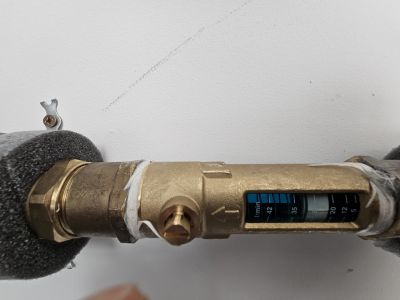New Installation - Grant Aerona 3 + 210L Hot Water Cylinder
I have just got the Grant Aerona 3 (10KW) + 210L Hotwater Cylinder installed. Wanted to share the details and also perhaps keep updating this post with findings, improvements etc as I go about optimising it with your help. Hopefully it will help future adopters instead of running around the forum reading endless threads 🙂
House : Detached, 4 bedroom, room details below
Location: Scotland
Heat Loss Details:
Current Grant Controller Settings:
1. Weather Compensation ACTIVE
2. LWT 50 @ -7 Deg C
3. LWT 30 @ 20 Deg C
4. Hysteresis @ 4
Hotwater Thermostat Setting @ 55 Deg C.
Issues/Queries:
1. Ground Floor : All rads except the living room rad get warm uniformly.
For this, I went around bleeding all the rads to get to this level.
2. 1st Floor: All rads don't seem to warm up as the ground floor.
I have tried bleeding them, but seems like some rads give out a dirty fluid rather than "bluish" fluid that was put in. the Ground floor rads give out "bluish" fluid like I would expect from a new filled system. I understand they wont get hot but there is absolute no sign of heat, probably still air trapped or needs a full flush?
3. Thermostat: Nest thermostat existing was used
I do understand from this forum it does nothing other than ON/OFF so set it high to keep the pump running. Don't care if I have to get rid of it and use somethign else, but what?
4. Target Temperature:
I am trying to keep the home at 21 deg C which feels comfortable for me. Currently nest wont go above 20 Deg C (living room read)
5. Radiator Balancing:
I have not yet done this. Been Learning about this. Currently standard TRVs and lockshield valves - Danfoss.
6. Hot Water heating:
I dont understand how this works. The thermostat on Cylinder is set at 55 deg C. Boost set to come on 2 hours in the morning and 3 hours in the evening. The hot water shower is good but wondering if this is overkill. The Boost is nest default settings (2 + 3 hour split) so I have not yet scheduled anything.
Does it not top up the temperature as it goes below 55 deg c? or do I have to do something to keep it there ? or is the Boost actually what should be used (I guess thats the answer but confirming)
I have only paid half the cost to the contractor till them come to sort it out but I don't think they have any clue (I am not surprised!). I have been told they will come to sort things out, nothing yet! ( will update as it progresses)
Hoping someone can help me optimise this along with some clear understanding of some of the issues/queries.
Any more information anyone needs please let me know I shall update the original post itself.
Thanks a ton in advance!
Hi, and welcome to the forums.
Your installation looks nicely insulated, and according to the Grant standards with a LLH involved (whether this is good or bad is open to debate).
Is this a new install or an upgrade from another system? Do you know the design power requirement (i.e. the kW you should be expecting at the design temperature)? The flow of 22l/m might seem a little low, but that will depend on your target heat output (although Grant quote for a delta T of 8C it's more likely that 5C is the best you'll see, which varies what flow rate you should aim for).
Regarding your specific questions:
2. 1st Floor: All rads don't seem to warm up as the ground floor.
I'd expect nice clean water to emerge if you've had new radiators and pipework (or if old rads and pipework a power flush should have been performed). If it's not clean water, get the installer to sort that. It will be rubbish in the pipes, or maybe an air pocket, but those should flush out in a few days or weeks.
3. Thermostat: Nest thermostat existing was used
The Nest is fine. Although it does do OpenTherm the Grant doesn't so it will be simple on/off, but once you get weather compensation (WC) sorted, it will simply be "on" all the time, and the WC will sort out modulating the internal temperature. ASHP is "low and slow" so it just runs 24x7 (again, there is debate about the merits of this strategy, but either way, don't run like a traditional boiler set-up with "on" and "off" times). As you say, leave it slightly higher than what you want to be a failsafe if you're getting too warm.
5. Radiator Balancing:
Certainly do this. It takes time, and multiple "passes" i.e. once you've balanced them all once, you might then need to go back and look again at the first ones you balanced. It's a slow process to be patient with, and do when there's a call for heating everywhere. Usually colder days make this easier. I'd switch to a fixed LWT when doing this.
6. Hot Water heating:
The HP heats CH or HW. The Nest HW times will determine the HW heating times. The 55C on the cylinder is the temp the cylinder's own thermostat is set to when the internal element is used, the HP has it's own setting which you can change (parameter 31 11). Around 50C is usually good enough, but that depends on your home requirements for HW. I have mine on only for 1 hour a day; you might need more. 5 hours seems like a lot.
Usual Grant installation will not be set to "top up" the HW. Once it's gone, it's gone. You can still 'boost' as normal if you need extra HW.
There should also be a scheduled weekly anti-legionalla cycle which is when the cylinder's heater will be used to get to a higher (55C in your case) setting. This won't use the HP.
Hope this is reasonably clear. Sadly the Grant controller isn't very user-friendly, and you have to dive into the Installation Guide to see how to display and amend the many settings.
Grant Aerona 3 10kW
Posted by: @mikeflHi, and welcome to the forums.
Thank you.
Your installation looks nicely insulated, and according to the Grant standards with a LLH involved (whether this is good or bad is open to debate).
Thank you for taking the time to review my information. What is LLH, first time hearing this term?
Is this a new install or an upgrade from another system?
Yes, brand new system previous one was a gas combi boiler.
Do you know the design power requirement (i.e. the kW you should be expecting at the design temperature)?
Where do I find this information ?
The flow of 22l/m might seem a little low, but that will depend on your target heat output (although Grant quote for a delta T of 8C it's more likely that 5C is the best you'll see, which varies what flow rate you should aim for).
Noted. Shall check when the contractors are back for a review.
Regarding your specific questions:
2. 1st Floor: All rads don't seem to warm up as the ground floor.
I'd expect nice clean water to emerge if you've had new radiators and pipework (or if old rads and pipework a power flush should have been performed). If it's not clean water, get the installer to sort that. It will be rubbish in the pipes, or maybe an air pocket, but those should flush out in a few days or weeks.
When I was bleeding some rads, Some were clean blue fluid and some were just dirty greenish water especially in the 1st floor, the bottom floor just had some air traps. I don't think they flushed the system and have requested them to flush and bleed again. Waiting for their visit.
3. Thermostat: Nest thermostat existing was used
The Nest is fine. Although it does do OpenTherm the Grant doesn't so it will be simple on/off, but once you get weather compensation (WC) sorted, it will simply be "on" all the time, and the WC will sort out modulating the internal temperature. ASHP is "low and slow" so it just runs 24x7 (again, there is debate about the merits of this strategy, but either way, don't run like a traditional boiler set-up with "on" and "off" times). As you say, leave it slightly higher than what you want to be a failsafe if you're getting too warm.
I set the Nest at 24 Deg C and its eventually hit 21 Deg C today but its also warm out here today so shall keep at 24 Deg C to continuous run. I have double checked,
Current Grant Controller Settings: (not sure if I have tweak this but how to determine the parameters?)
- Weather Compensation ACTIVE
- LWT 50 @ -7 Deg C
- LWT 30 @ 20 Deg C
- Hysteresis @ 4
5. Radiator Balancing:
Certainly do this. It takes time, and multiple "passes" i.e. once you've balanced them all once, you might then need to go back and look again at the first ones you balanced. It's a slow process to be patient with, and do when there's a call for heating everywhere. Usually colder days make this easier. I'd switch to a fixed LWT when doing this.
Noted. Will set the LWT at 50 Deg C fixed and go from there, when I get around it.
6. Hot Water heating:
The HP heats CH or HW. The Nest HW times will determine the HW heating times. The 55C on the cylinder is the temp the cylinder's own thermostat is set to when the internal element is used, the HP has it's own setting which you can change (parameter 31 11). Around 50C is usually good enough, but that depends on your home requirements for HW. I have mine on only for 1 hour a day; you might need more. 5 hours seems like a lot.
Noted, I shall check 31 11 parameter and set it to 50 Deg C. We dont use lot of hotwater except for some quick manual dishwashing and shower end of the day.
Usual Grant installation will not be set to "top up" the HW. Once it's gone, it's gone. You can still 'boost' as normal if you need extra HW.
Noted. Does this mean when I boost it uses the ASHP or the immersion ?
There should also be a scheduled weekly anti-legionalla cycle which is when the cylinder's heater will be used to get to a higher (55C in your case) setting. This won't use the HP.
Aware of this, been informed this is set at the HW switch to come on 2 hours every Monday 6-8am to raise the temps to 65 Deg C weekly apparently. Does this bypass the HW cylinder thermostat?
Hope this is reasonably clear. Sadly the Grant controller isn't very user-friendly, and you have to dive into the Installation Guide to see how to display and amend the many settings.
Agreed, not the best. But I am a bit technically handy and have some patience to deal with it provided I understand it 😀
My responses and comments in BLUE to make it easier for context.
LLH = Low Loss Header - it's on the right of your 2nd picture, and has 4 connections. The two on the left are the flow/return from your ASHP; and the two on the right are the flow/return to your CH/HW (the top is flow; bottom is return). Grant add them as a matter of course to their installations, which is different to most other manufacturers. They enable "hydraulic separation" so you have two water circuits; this makes installation easier, at the cost of some efficiency. The key within the Grant system is to match, as best as you can, the flows on either side of the LLH. Unfortunately only the HP side has a display of the flow rate (on the regulator) and the best a user can typically manage is to get the delta T the same on both sides, and that will mean flows are matched, roughly. This heat geek article is often cited as a simple guide to a LLH.
The design temperature for your system should have been agreed prior to installation. Somewhere (it's an MCS requirement) along with heat loss calculations for your house, there should be something stating what energy requirements you'll have at what indoor/outdoor temperature e.g. "when it's -3C outside, I want the house to be at 20C"; this then sets out how much energy you'll need to do this, based on how much heat your house will be losing at that outdoor temp. It's the baseline from which the installer should work to size your HP. Every house is different, and it depends not only on the house properties, but where it is in the country. That gives you the energy requirement in total, which sizes the HP; and then by room, the size needed for each radiator so they can all draw sufficient energy for that room.
The values for your WC 'curve' don't look so far off. It's something to adjust as you go along, but probably best to leave alone for now until the above has been addressed. In simple terms you lower the curve if your house gets too warm; and raise if it never hits temperature, but that all depends on getting the right set-up to start with.
For HW, the boost should still use the ASHP. The immersion is a separate element that the HP doesn't really know about. I don't have a Grant HW cylinder so unsure which setting the immersion obeys; hopefully someone with a Grant cylinder can clarify for you.
----
In terms of where you are, I think number 1 priority is a flush of your system. If they installed new pipework and rads, I'd expect everything to be clean anyway, so I'm guessing the pipework from the gas boiler was re-used? Either way, your water should be crystal clear after the install. Flow is crucial to HPs so you don't want gunk hitting your flow. You need that sorted, then to find out what the flow rate should be, and make sure you are getting that rate. After that, parameters can be adjusted to help with efficiency, but that's after the basics are sorted.
Grant Aerona 3 10kW
-
Where has Watson gone?
1 month ago
-
Bosch CS5800i 5kW - Experience So Far
1 month ago
-
First time wall mounting an ASHP
2 months ago
-
How can I programme a setback for my Samsung Gen6 8kW heat pump?
2 months ago
-
Rodents! A word of warning for heat pump owners
2 months ago
- 26 Forums
- 2,364 Topics
- 53.6 K Posts
- 316 Online
- 6,029 Members
Join Us!
Worth Watching
Latest Posts
-
RE: ASHP sizing - value of Heat Transfer Coefficient
Sorry, but I cant see what the point of this is unless ...
By JamesPa , 15 hours ago
-

RE: Octopus Cosy Heat Pump Owners & Discussion Thread
TC Thermostatic Radiator Valve TRV Plastic Decorators S...
By Toodles , 18 hours ago
-
RE: Ecodan unable to hit legionella target temp - what's the consensus?
UPDATE: Thanks everyone who commened with suggestions h...
By 9jwr9 , 23 hours ago
-
-

How long will your energy contract last?
Some heat pump tariffs don’t run as long as a heat pu...
By Toodles , 3 days ago
-

@morgan They are unsupervised these days, can’t get the...
By Toodles , 3 days ago
-
-

RE: Setback savings - fact or fiction?
Exactly. We only need to compare conditions, to decide ...
By cathodeRay , 4 days ago
-
RE: Balancing financial efficiency and comfort using the Octopus Cosy tariff
I found because I have very low heat loss I can set bac...
By RadWhisperer , 4 days ago
-
RE: Need Help Optimising My Rushed ECO4 Install: 12kW Bosch Heat Pump
Welcome @mickamills We too have an oversized 12kW Sa...
By Old_Scientist , 4 days ago
-
RE: My Powerwall 3 Consumes 3-4 kWh/Day in Self-Consumption: Is This Normal?
@caron I can confirm that the power usage of the PW3 is...
By Old_Scientist , 4 days ago
-
RE: Speedcomfort radiator fans
Thats true, but having tried (and succeeded) in constru...
By JamesPa , 5 days ago
-
RE: Solis S6-EH1P8K-L-PLUS – Why I Chose It and What I’ve Learned So Far
@bash brilliant, thanks for the feedback
By energy9165 , 5 days ago
-

RE: Heat Pump Heats the House… But It’s Not Cosy. Emitter Changes or System Tweak?
@alastair There I was, feeling grumpy, he said “Cheer u...
By Toodles , 5 days ago
-
RE: Grant Aerona: Is there a setting to keep the 2-port valve open during pump blockade
Depends on OAT. Mine cycles at OAT>10 and of course...
By JamesPa , 5 days ago
-
RE: New Fogstar 15.5kWh upright solution
@transparent My conclusion is as you have noted, tha...
By Bash , 5 days ago
-
RE: Mitsubishi Ecodan R290 10kW performance
And to you too. Wishing you a very enjoyable festive s...
By Sheriff Fatman , 5 days ago
-

RE: External pipework insulation
They do? But that isn't apparent from the photos we'r...
By Transparent , 5 days ago
-

RE: Say hello and introduce yourself
@velcro welcome to the forums. Please feel free start a...
By Mars , 6 days ago
-
Daikin EDLA11D3V3 DHW Settings
I have a newly installed EDLA11D3V3 which I'm still get...
By Velcro , 6 days ago







